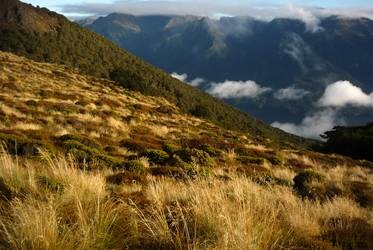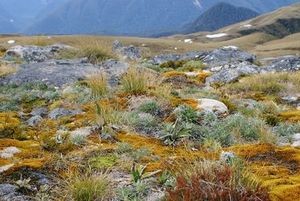 Lower alpine zone comprised of snow tussock and shrubs. Photo: Jesse BythellThe alpine zone represents the only biogeographical unit on land with global distribution. Depending on altitude, it can occur at any latitude. Alpine environments exist wherever a mountain reaches higher than the regional treeline. Separated by lowlands, these areas are isolated pockets of plant and animal diversity, which generally experience a more extreme climate (ie- colder temperatures and higher winds) than the forested regions below. In New Zealand, this constitutes a 1000m wide belt of vegetation with a high degree of morphological and taxonomic diversity such that it is often subdivided into low- and high-alpine zones. The low alpine zone ranges from ~400-600m and is characterized by tall (1.5m) grasslands codominated by the endemic evergreen snow tussock genus Chionochloa, and woody shrubs. Above the low-alpine, the high-alpine zone is dominated by sparse, low vegetation including grasses, forbs, cushions, mats, and dwarfed shrubs.
Lower alpine zone comprised of snow tussock and shrubs. Photo: Jesse BythellThe alpine zone represents the only biogeographical unit on land with global distribution. Depending on altitude, it can occur at any latitude. Alpine environments exist wherever a mountain reaches higher than the regional treeline. Separated by lowlands, these areas are isolated pockets of plant and animal diversity, which generally experience a more extreme climate (ie- colder temperatures and higher winds) than the forested regions below. In New Zealand, this constitutes a 1000m wide belt of vegetation with a high degree of morphological and taxonomic diversity such that it is often subdivided into low- and high-alpine zones. The low alpine zone ranges from ~400-600m and is characterized by tall (1.5m) grasslands codominated by the endemic evergreen snow tussock genus Chionochloa, and woody shrubs. Above the low-alpine, the high-alpine zone is dominated by sparse, low vegetation including grasses, forbs, cushions, mats, and dwarfed shrubs.
 High alpine zone community including herbs, prostrate shrubs, mosses and lichens. Photo: Anne Humburg.Estimates of total global area covered by alpine vegetation are difficult because alpine environments are often treated as arctic, tundra or bare ground in databases. However, an area of 4 million km2, or roughly 3% of the terrestrial surface of the earth has been suggested.
High alpine zone community including herbs, prostrate shrubs, mosses and lichens. Photo: Anne Humburg.Estimates of total global area covered by alpine vegetation are difficult because alpine environments are often treated as arctic, tundra or bare ground in databases. However, an area of 4 million km2, or roughly 3% of the terrestrial surface of the earth has been suggested.
Geographic isolation, tectonic uplift, climatic changes, glaciation, microhabitat differentiation, migration and evolution have lead to a high degree of biodiversity in alpine regions. Slope aspect, for example, can greatly influence alpine vegetation. Narrow mountain valleys, where the shaded side may receive no sunlight for three months of the year, may remain frozen while the opposite side, receiving the suns rays, is relatively warm. Alpine systems in New Zealand differ from most because of the oceanic influences which result in less extreme, but more frequently and severely fluctuating temperatures.
While the factors listed above have resulted in high diversity within alpine environments, there are certain drivers which affect all alpine communities. Alpine plants are subject to cold temperatures, shorter growing seasons, increased solar radiation and precipitation, high winds, and a greater occurrence of mist and clouds. This extreme environment has influenced the forms adopted by alpine plants to survive the elements. Of the estimated 8000 to 10000 alpine species which exist globally, most fall into one of four categories:
- low stature (prostrate) woody shrubs
- grasses and sedges (often forming tussocks)
- herbaceous perennials (often forming rosettes)
- cushions
As with many of New Zealand’s wild places, land use and recreation threaten alpine environments. Grazing by livestock, off-road vehicles (quad bikes and dirt bikes), and irresponsible trampers (trampling and accidentally introducing propagules of exotic plants) can cause severe and irreparable damage to even the hardiest alpine plants. However, the threat posed by climate change is perhaps even more immediate. As the climate warms, ranges of treeline species are predicted to advance upslope. This will drastically reduce not only New Zealand’s alpine areas, but alpine environments around the globe, and in some instances may eliminate them all together.
For more information about alpine ecosystems see:
- Alpine plants (Te Ara Encyclopedia of New Zealand)
- Alpine plants factsheet
- Alpine plants (from John Dawson’s New Zealand Plants and their story)
- Adaptations of alpine plants (from John Dawson’s New Zealand Plants and their story)
- Alpine Ecology Research Group
- Granite sand plains (Landcare Research)
